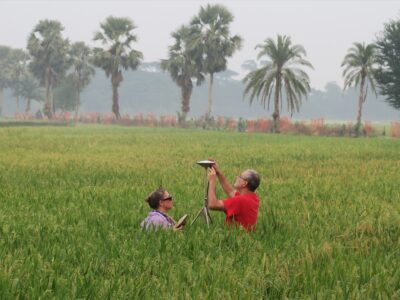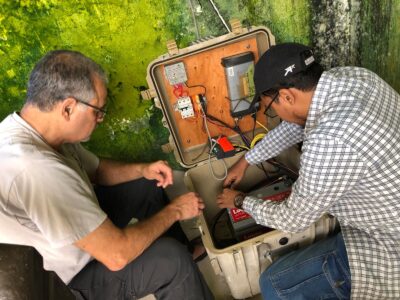
We spent the entire day traveling to get to Khepupara, not far from the Bay of Bengal. We had heard that there were problems at Mawa Ghat, the ferry crossing of the Padma River immediately south of Dhaka due to siltation on one side and erosion on the other. We decided to head west to Aricha, the shorter ferry ride near the confluence where the Ganges and Brahmaputra meet to become the Padma. Unfortunately, the traffic to get out of Dhaka on the western side was so bad, that it and the longer route lost us more time than using Mawa. We didn’t arrive at Khepupara until after dark even though we started before 6AM. At least after the ferry, we had beautiful scenery of rice fields and forests. I am always glad to get away from Dhaka traffic.

Khepupara is a site where a long tide gauge record shows a very rapid rise of water level implying sinking of the land. However, tide gauges are not designed to be stable over decades, so I don’t trust the rate. We are putting a GPS here to get our own subsidence rate in a few years time. Humayun arranged for it to be installed at the Bangladesh Meteorology Department (BMD) weather radar station. We stayed in their guesthouse, pretty basic accommodations, but it suited us just fine. We walked to a local restaurant for some delicious Bangladeshi food then started preparing the equipment to save time. That took us up to about 11:30 PM with a few short power outages. Then we crashed.

The next morning we started at 6AM to install before breakfast. We went to meet the officials and check out the suitability of the roof of their headquarters building, once a ladder was found. It was reinforced concrete, but the two good corners of the highest roof had a weather vane and anemometer installed. The two back ones had their sky view blocked by a water tank. We went back to the guesthouse and decided that its roof was the better option and had to carry everything back. By the time we finished installing the antenna, the solar panels to power it, grounding rods and lightning protectors, etc. and Sarah checked that everything was working, it was 11AM. Breakfast became brunch for our famished group.

This site took longer, in part, because it will have cellular communications. The three coastal sites we are doing are very remote, particularly the other two that can only be reached by boat. We decided to use cellular modems. Every day UNAVCO in Boulder, CO will be able to call up the GPS and download the day’s data. It will only have to be visited if it stops working. Using solar panels with 2 car batteries to store power, the system is very self contained.

Two down. Next, we drive northwest to get on a boat to take us to Polder 32. An inland island whose embankments to protect the area from flooding failed during Cyclone Aila leaving it underwater for most of two years. Our late finish meant abandoning two secondary items on our agenda. Visiting our compaction meter site to download the GPS data and installing a replacement GPS at Khulna University to replace the one that is no longer working. Humayun will come down here in November to do it himself. While they are close to on our way, we don’t reach the boat until after dark. It is the M.V. Kokilmoni, the boat that I lived on for two weeks last year when we did a month-long seismic cruise on the rivers throughout Bangladesh.




